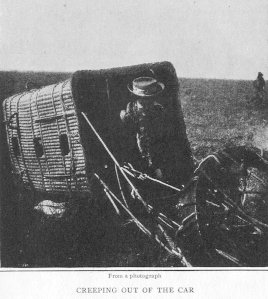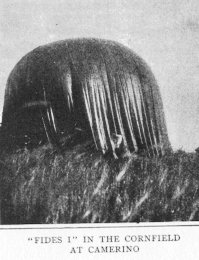Balloon over the Apennines
Today, an interlude in the early days of flight. The University of Houston's College of Engineering presents this series about the machines that make our civilization run, and the people whose ingenuity created them.
"Sport of the gods!" cries the Contessa Grace di Campello Della Spina. Queen Margherita of Italy founded the Roman Aero Club in 1904. Now it's 1907. The Contessa is an ardent member of the club. Her sport of the gods is ballooning.
First she flew on a tether rope. Now she readies her second ascent. It's her honeymoon. She, her new husband, and a pilot are about to fly over the Apennines, to the other side of Italy.
They take off at 9:30 in the evening. The contessa rhapsodizes: "A full-orbed moon was just appearing in a mist of golden glory above the Alban Hills ..." She tells how to pack for the trip. "Bring the simplest and most practical tailor-made suit of light wool. Take an umbrella. The sun bites hard in the South."
She chooses her food carefully. "It should be light and easily eaten. French Prunes, raisins and chocolate -- cold tea, mineral water, and well-baked bread. Bring a light volume of your favorite author, and no alcohol save a small flask of brandy in the case of faintness."
On to details of the flight. The name of their balloon is the Fides I. It has a rip valve so they can let gas out and land. But it's better to throw down a rope, so the peasants below can tow you in.
At last they rise into the night sky. The view is lovely. At one point they see their reflection in a pillar of cloud, by moonlight. The Contessa describes dawn: "On the wings of the stiffening morning breeze we raced along in joyous flight like happy swallows ..."
The trip ends in a cornfield. "The peasants, seeing us descending from afar, ran from all sides to help pack the balloon, and claim damages for the corn." She sits on the passenger car and chats with the peasant women. "They are most primitive and full of rustic curiosity," she says.
The next day she catches a train back to Rome. The trip takes 24 hours on the ground. The honeymoon has ended.
A few years later, those balloons would become a weapon in the most terrible war we'd ever seen. When the smoke cleared, the world had begun dismantling her royal class.
So where did flight come from? It didn't come from people who wanted to wage war or create transportation systems. The Contessa, with all that money to lavish on play, was the true ally of human progress. Her aim, like that of the technologists she supported, was the pursuit of pleasure. And pleasure is what's always driven the best technologists.
I'm John Lienhard, at the University of Houston, where we're interested in the way inventive minds work.
(Theme music)
Di Campello Della Spina, G., Ballooning by Moonlight: Narrative of a Woman's trip over the Apennines. The Century Magazine, May 1907. (Reprinted by Oppel, F., Early Flight: from Balloons to Biplanes. Secaucus, NJ: Castle, 1987, pp. 253-259.) Two pictures from the Contessa's article follow:

